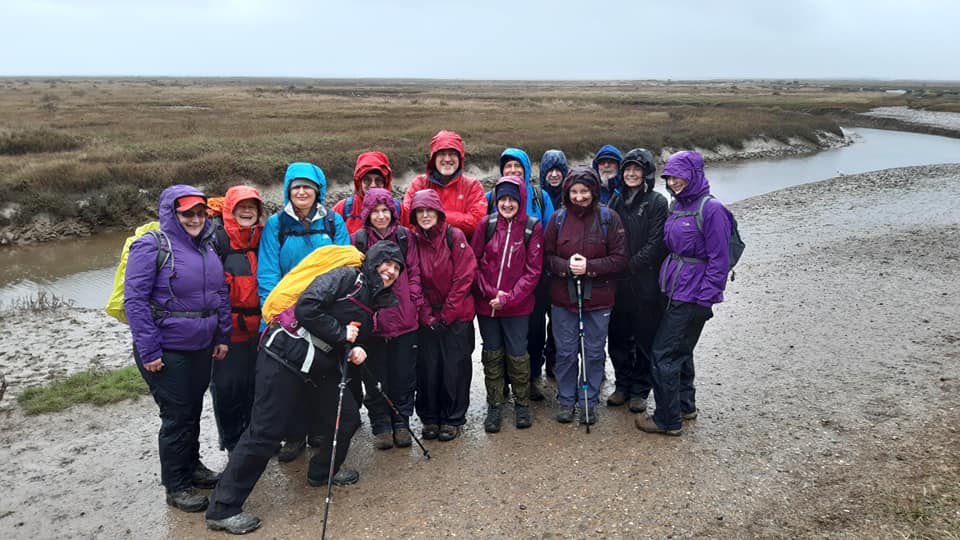What to wear or take with you for any activity is a personal choice; these are some suggestions that you may find helpful to give you some ideas of what you might need. If you don’t have the correct kit, this can both endanger your safety and those of the others in the group; thus, always consider the activity and the likely weather and pack accordingly. If in doubt, ask the activity leader and they will be happy to offer advice.
CLOTHING
Layering (top half of body):
Base – Long- or short-sleeved, high wicking and breathable thin layer against the skin (not cotton).
Mid – Thin fleece or garment marketed as a ‘mid-layer’. A neck zip is recommended for easy ventilation.
Top – Fleece, pile, insulated or soft-shell jacket garment.
Shell – AKA waterproof to go over the top to block wind and rain. Breathable is recommended and a hood with a peak and draw-string is even better.
Trousers
Trousers – Lightweight material that is mainly windproof and will dry easily (not jeans).
Waterproof trousers – Nothing fancy needed, but breathable is recommended. For use when it’s extremely wet and/or windy.
Accessories
Gloves – Mittens are generally warmer but gloves give better dexterity. Some are marketed as being waterproof and these are very handy on a hill to keep your hands warm and dry when it’s cold and pouring down with rain.
Hat – All different types are available, but something to cover your ears is a good idea.
Buff – A very handy, versatile, small, light and inexpensive piece of neck and/or head equipment. Recommended!
Feet
Footwear – Three-season boot types for general hill walking; two-season boots are ok for East Anglia summer use. Full leather boots are easy to clean and maintain after being caked in mud, but can be heavy(ish). Fabric boots (with a waterproof liner) are lighter but harder to clean of mud, which gets and stays in the outer fabric and can destroy the waterproof liner over time.
Fabric boots are great for summer use because of their ability to let your feet breathe (although the boots will still need to be proofed with a spray). Make sure that they are comfortable at all foot walking angles and have a little room for your feet to expand when they get hot from walking.
Footbeds – AKA innersoles. Boots usually come with a ‘basic’ footbed that can become compressed and hard with use (or just hard to begin with). Replacement footbeds can give better support, compression/spring and overall comfort, but need to be of the correct thickness to ensure that your foot still fits correctly inside the boot, because a foot sitting too high inside the boot can cause rubbing blisters.
Socks – Those designed for hiking and that help to allow your feet to breathe whilst cushioning your feet against the inside of the boot are recommended. Some people use a thin liner (walking) sock, with a thicker walking sock over the top. It’s personal preference what method you choose.
Gaiters – Great for preventing your trousers from getting muddy and stopping mud, snow and any other object(s) getting into the top of your boots. Your feet can get hotter when wearing them though as they prevent your feet breathing by moisture not escaping from the top of your boots when walking. Good for winter use.
CLOTHING CARE
Care of waterproofs – Wash off mud and clean with a non-detergent cleaner (follow instructions), then reproof. A spray designed for breathable clothing applied to the outside of the garment only is recommended.
Boot care (1) – Wash off mud and allow to dry naturally and thoroughly before reproofing the outside with a wax-like substance for leather or a proofing spray for fabric.
Boot care (2) – Once a year, wash your boots to clean off the outside, then remove the footbeds. With warm clean water and non-detergent cleaner, totally submerse your boots and footbeds and wash by hand throughout. This will help get rid of salt crystals inside the boots (formed when your feet sweat), which stops your feet from breathing. It also helps to get rid of boot odour. Leave to dry naturally and thoroughly before reproofing the outside of the boots and reinserting the footbeds.
RUCKSACKS AND WHAT TO CARRY IN THEM
Around 40 litres is typically recommended with enough room to carry water, food, clothing and sitmat for the walk, plus first aid kit and other essentials for winter hill walking (including room to stash clothing if you get too hot). If walking in East Anglia, a smaller rucksack will usually suffice.
Summer walks:
- Water – Bottles or hydration pack; at least 2 litres and possibly more
- Trail food/slow-energy-release foods
- Any personal medication
- Small first aid kit
- Sun hat
- Sun cream
- Sun glasses
- Lightweight waterproof
- Waterproof trousers (if there’s a chance of rain)
- Sit mat
- Packed lunch if needed
Winter walks:
- Water – Bottles or hydration pack; at least 2 litres
- Flask of hot drink
- Trail food/slow-energy-release foods
- Any personal medication
- Small first aid kit
- Waterproof top
- Waterproof trousers
- Spare upper clothing layer
- Gloves and warm hat
- Spare walking socks
- Torch and spare batteries
- Sit mat
- Packed lunch
Spring and autumn walks:
Aim towards items for a winter walk.
